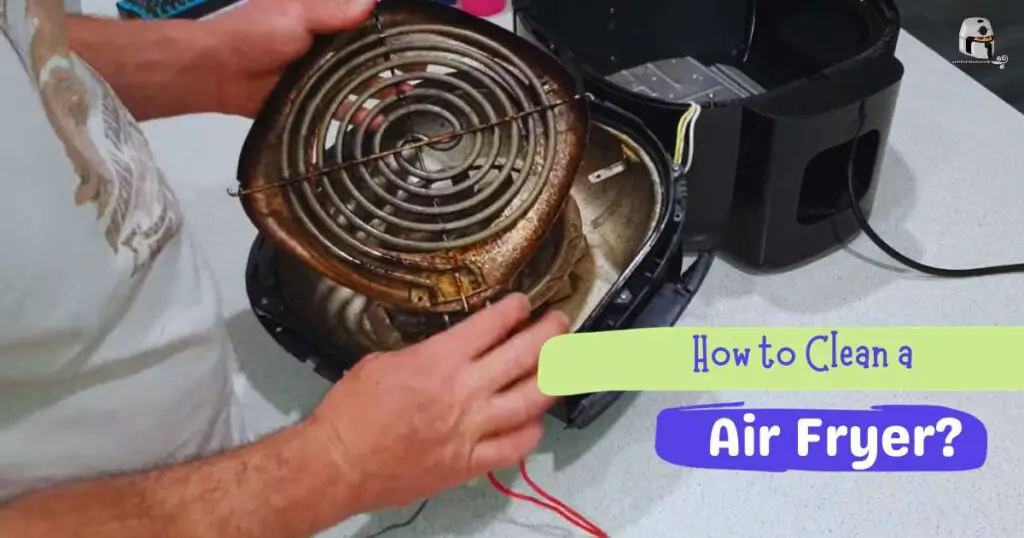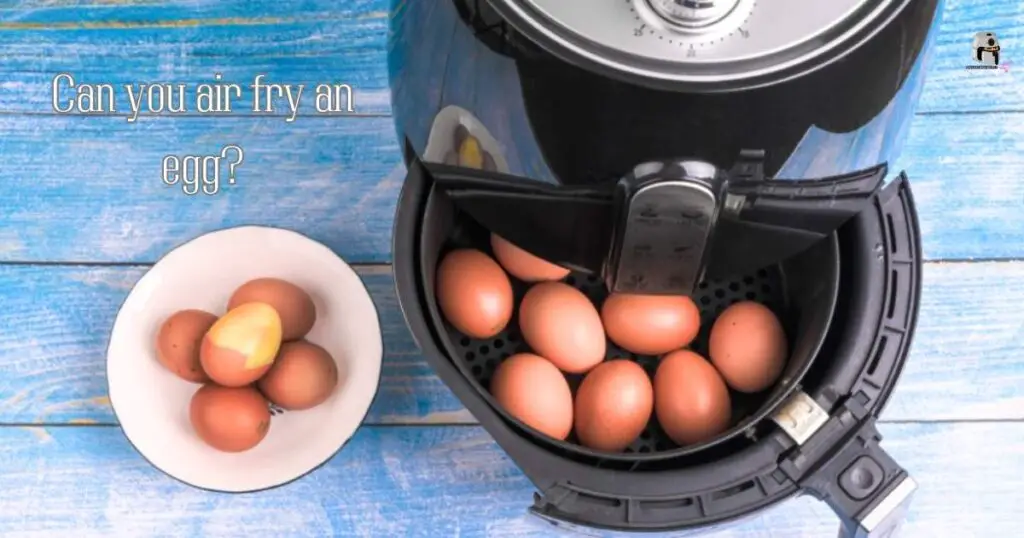Table Of Contents
Cleaning an air fryer is essential for maintaining its performance and ensuring your food remains delicious. Start by unplugging the appliance and allowing it to cool down. Remove any removable parts, like the basket or pan, and wash them with warm, soapy water or place them in the dishwasher if they’re dishwasher-safe.
Use a soft brush or toothbrush to clean the interior gently, taking care not to damage the nonstick coating. Wipe the exterior with a damp cloth, avoiding the control panel.
For odors, you can deodorize by running the air fryer with a bowl of water and lemon slices. Regular cleaning will keep your air fryer in top shape.

Step-by-step Instructions on How to Clean a Air Fryer?
Cleaning your air fryer is essential for maintaining its performance and preventing the accumulation of food residues and aromas. Here are step-by-step instructions for effectively cleaning an air fryer:
Materials Required
- Dishwashing liquid or mild soap
- Soft sponge or cloth
- Non-abrasive brush or toothbrush
- Warm water
- Soft, dry cloth or paper towels
- Removable parts of the air fryer (if applicable)
Step 1: Unplug and Cool Down
Safety first. Ensure your air fryer is unplugged, and let it cool down completely before beginning the cleaning process. This will prevent any accidents or burns.
Step 2: Remove Accessories (If Applicable)
Most air fryers have removable parts like the basket, tray, or pan. Take them out for easier cleaning and set them aside.
Step 3: Wipe Exteriors
Use a damp, soft cloth or sponge to wipe down the exterior of the air fryer. Pay attention to the control panel, vents, and any buttons or knobs. Be gentle and avoid letting excess water seep into the appliance.
Step 4: Clean the Basket or Pan
If your air fryer has a removable basket or pan, wash it with warm, soapy water. Use a non-abrasive brush or sponge to remove any stuck-on food particles. You can also place it in the dishwasher if labeled as dishwasher-safe. Rinse the basket or pan thoroughly and allow it to air dry completely.
Step 5: Clean the Interior
Inside the air fryer, use a soft brush or toothbrush to remove any food residue or stuck-on particles gently. Pay close attention to the heating element and the walls of the cooking chamber. Be careful not to damage the nonstick coating or any other components.
Step 6: Clean the Heating Element
If there’s any grease or residue on the heating element, use a soft, damp cloth to wipe it down. Ensure that it’s completely dry before plugging in the air fryer again.
Step 7: Deodorize (Optional)
To combat odors, you can place a small bowl of white vinegar or water with lemon slices in the basket and run the air fryer at a low temperature for a few minutes. This will help neutralize any lingering smells.
Step 8: Reassemble and Store
Once all the cleaned parts are dry, reassemble your air fryer. Store it in a dry, cool place, ready for your next cooking adventure.
By following these detailed steps, you can maintain your air fryer in excellent condition, ensuring that it continues to function efficiently and that your meals are consistently delicious.
Why is it important to clean an air fryer?
Cleaning your air fryer is essential for several reasons
1. For Food Safety
Food particles and grease residues left behind from previous cooking sessions can become a breeding ground for harmful bacteria. If not cleaned properly, these contaminants can pose a food safety risk, potentially causing foodborne illnesses.
2. Performance Optimization
A clean air fryer functions more effectively. When food particles accumulate on the heating element, fan, or cooking chamber, they can obstruct hot air flow. This obstruction leads to uneven cooking, longer cooking times, and diminished food quality. Regular cleaning ensures optimal air circulation, resulting in better-cooked meals.
3. Smoke and Odor Prevention
The buildup of grease and food residues can lead to smoke and unpleasant odors during cooking. Cleaning the air fryer, especially the drip tray and cooking chamber, prevents these issues, creating a more pleasant cooking experience.
4. Prolonged Lifespan
Grease accumulation on heating elements and other critical components can lead to wear and tear over time. Cleaning helps prevent damage and extends the lifespan of your air fryer, potentially saving you money in the long run.
5. Flavor Consistency
Lingering food odors and residues from previous meals can negatively impact the flavor of new dishes. Cleaning the air fryer ensures that your food retains its intended flavors, promoting consistency in taste and quality.
6. Aesthetics
A well-maintained and clean air fryer functions better and looks more inviting in your kitchen. Regular cleaning prevents unsightly stains and discolorations, maintaining the appliance’s appearance.
WHEN & HOW OFTEN TO CLEAN YOUR AIR FRYER
Knowing when and how often to clean your air fryer is crucial to ensure its longevity and maintain food safety. Here’s a guide:
After Each Use:
1. Immediate Cleanup
After each use, wait for the air fryer to cool down, and then unplug it. Empty the cooking basket and remove any food residues or crumbs. You can tap the basket over a trash bin to remove loose particles.
Wipe the inside of the cooking chamber with a damp cloth or paper towel to remove any remaining residue. Cleaning right after use prevents the buildup of tough, stuck-on food.
Weekly Cleaning:
2. Basket and Tray
Once a week, remove the cooking basket and tray. Fill your sink or a basin with warm, soapy water and let them soak for about 10-15 minutes. This helps to loosen any stubborn food residues. After soaking, gently scrub the basket and tray with a non-abrasive sponge or brush.
Rinse them thoroughly under running water and allow them to air dry completely before reassembling them.
Monthly Cleaning:
3. Exterior
On a monthly basis, clean the exterior of your air fryer. Ensure that it’s unplugged. Use a damp cloth or sponge to wipe down the exterior surfaces, including the control panel, handles, and cord.
Be careful not to get water inside the appliance. Dry the exterior thoroughly to prevent any moisture from entering the electrical components.
Quarterly Cleaning:
4. Heating Element and Fan
Every few months, consider a deeper cleaning, which may involve accessing and cleaning the heating element and fan. Check your air fryer’s manual for specific instructions on how to do this. Some models have removable heating elements and fans for easier cleaning.
For others, you may need to use a brush or vacuum attachment to remove dust and debris.
As Needed:
5. Deep Cleaning
If you notice persistent stains, odors, or a decline in your air fryer’s performance, it’s time for a thorough deep cleaning. This should include disassembling as many parts as possible (if your model allows) and cleaning them individually.
Remove built-up grease and residue from all components, including the heating element, fan, and any removable parts like the basket and tray.
Remember that cleaning frequency can vary based on usage. If you use your air fryer frequently, you may need to clean it more often. Regular maintenance ensures safe and efficient cooking and prolongs the appliance’s lifespan. Consult your air fryer’s manual for specific cleaning instructions tailored to your model.
What to Avoid When Cleaning an Air Fryer
When cleaning your air fryer, there are certain things you should avoid to prevent damage and maintain its performance. Here’s what to avoid:
- Submerging the Appliance
Never immerse the entire air fryer in water or any liquid. Submerging electrical components can cause damage, electrical hazards, and even complete malfunction.
- Abrasive Scrubbers
Avoid using abrasive scouring pads, steel wool, or abrasive cleaning tools on any part of the air fryer, including the basket and tray. These can scratch the nonstick coating, making it less effective and potentially exposing the underlying material.
- Harsh Chemicals
Refrain from using harsh chemicals or caustic cleaning agents such as oven cleaners, bleach, or industrial-strength cleaners. Stick to mild dish soap and warm water for cleaning, as these are safe and effective.
- Dishwasher for All Parts
While some air fryer accessories are dishwasher-safe, not all components can withstand the high temperatures and aggressive water jets of a dishwasher. Always check your air fryer’s user manual for guidance on which parts are dishwasher-safe.
- Neglecting the Heating Element and Fan
These are crucial components that can accumulate grease and debris over time, affecting both performance and safety. Consult your air fryer’s manual for instructions on cleaning or accessing these parts.
- Excessive Force
When cleaning, be gentle, especially when handling removable parts like the cooking basket and tray. Scrubbing too vigorously can damage the nonstick coating or other sensitive components.
- Failure to Cool Down
Before cleaning, ensure that your air fryer has cooled down completely. Cleaning hot surfaces can lead to burns, and hot oil may splatter, causing safety hazards.
- Skipping the Interior
Neglecting to clean the interior, including the cooking chamber and fan area, can result in the buildup of food residue and grease. Regularly wipe down these areas to maintain optimal cooking performance.
- Neglecting the Seal or Gasket
The seal or gasket on the air fryer’s lid is crucial for maintaining proper heat circulation and cooking efficiency. Regularly clean and inspect it to ensure it’s free from debris or food particles.
- Not Following the Manufacturer’s Instructions
Manufacturers may have specific recommendations for cleaning their air fryer models. Always follow the cleaning instructions in the user manual to ensure you maintain the appliance correctly.
By avoiding these cleaning pitfalls, you’ll keep your air fryer in excellent condition, ensuring safe, efficient, and delicious cooking every time you use it.
Tips for Cleaning Air Fryer Cleaner Longer
Certainly, here are some tips for keeping your air fryer cleaner for longer:
- After each use, make it a habit to clean the air fryer promptly. The longer food residues sit, the more difficult they become to remove.
- Consider using air fryer-specific liners or parchment paper. These can prevent direct contact between food and the basket or tray, reducing the chances of stubborn residue buildup.
- Before cooking, lightly spray the basket or tray with a nonstick cooking spray. This minimizes food sticking and makes cleanup easier.
- Don’t overcrowd the basket or tray with food. Overcrowding can lead to uneven cooking and increase the likelihood of food debris falling into the heating element.
- Foods high in fat can splatter and create a mess. Use aluminum foil or a splatter guard to prevent grease splatters from accumulating inside the air fryer.
- For items like baked goods or delicate foods, use parchment paper or silicone liners. Ensure they are suitable for air fryer use and won’t melt.
- Even if you’re not doing a full cleaning, wiping down the interior with a damp cloth after each use can help prevent residue buildup.
- Periodically, perform a deep cleaning. Consult your air fryer’s manual for disassembly instructions. Clean all components thoroughly, including the heating element and fan.
- For stubborn residues, soak the parts in warm, soapy water. This can help loosen the debris, making it easier to scrub off.
- To tackle stains or persistent residues, create a paste using baking soda and water. Apply it to the affected areas, let it sit, then scrub gently.
- Use soft brushes, sponges, or microfiber cloths for cleaning. Avoid abrasive materials or harsh scouring pads that could damage nonstick surfaces.
- Ensure all components are completely dry before reassembling or storing the air fryer. Moisture can lead to mold growth or electrical issues.
- Store your air fryer in a clean, dry area. Cover it when not in use to prevent dust and debris from accumulating inside.
- If you notice any components are damaged, including the basket, tray, or heating element, consider replacing them to maintain cleanliness and cooking performance.
By following these tips and maintaining a regular cleaning routine, you can keep your air fryer cleaner for longer, extend its lifespan, and ensure it continues to produce delicious, healthy meals with ease.
FAQs
Is It Ok to Put Water in Air Fryer to Clean?
No, it’s not ok to put water in air fryer to clean. Water can damage the heating element and other electrical components. Instead, clean the removable parts like the basket, tray, and pan separately with warm, soapy water. Wipe down the interior of the air fryer with a damp cloth if needed.
How Long Will This Take to Clean Air Fryer?
The time it takes to clean an air fryer typically falls within the range of 10 to 30 minutes. Factors that influence the cleaning duration include the air fryer’s size, dirt and grease buildup level, and your familiarity with the cleaning process. More extensive cleaning or stubborn residues may require more time and effort.
Can You Clean an Air Fryer in the Dishwasher?
No, you cannot clean an air fryer in the dishwasher. Dishwashers employ intense heat and steam, which can harm nonstick coatings and internal appliance components. To preserve the longevity of your air fryer, cleaning it by hand according to the manufacturer’s recommendations is safer and more effective.
Final Verdict
Properly maintaining the cleanliness of your air fryer is crucial to ensure its longevity and keep it performing at its best. Consistent cleaning practices extend the lifespan of your appliance. They also guarantee that they continue producing delicious and healthy meals without hassle.
For specific cleaning instructions tailored to your air fryer model, always refer to the manufacturer’s manual. By following these guidelines, you can enjoy worry-free cooking experiences and savor the benefits of this versatile kitchen appliance.
You May Also Like to Read:







